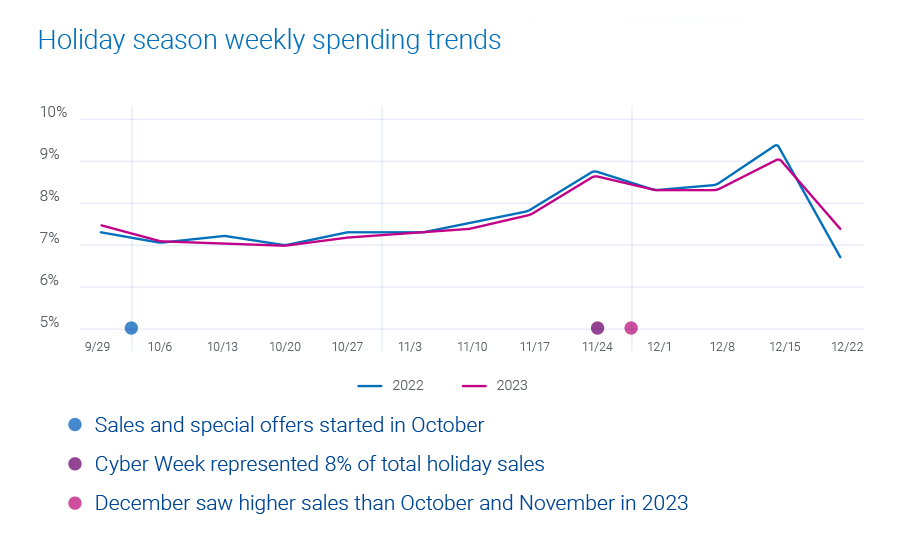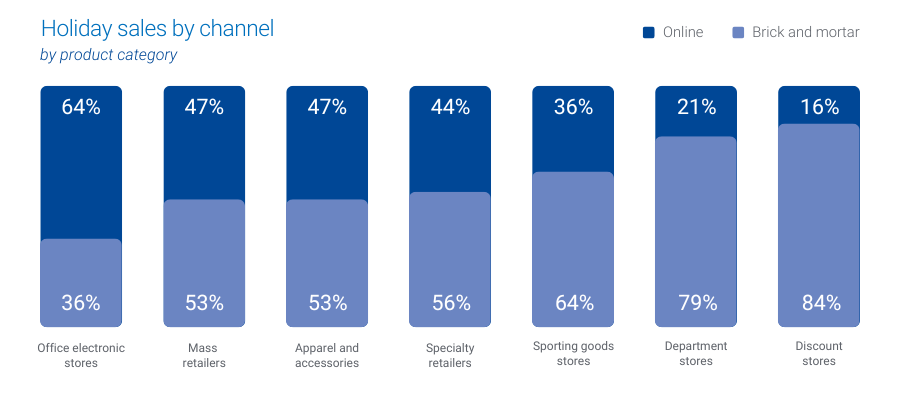
This holiday shopping season, marketers will look to take advantage of the surge in spending across channels like connected TV (CTV), programmatic, and mobile. Despite challenges such as privacy regulations and Google’s new cookie deprecation plan, this moment presents a unique opportunity for marketers to reshape their traditional approaches to consumer engagement and capitalize on these changes.
As we approach the holiday season, understanding how consumers spend, where they shop, and how their shopping habits are changing are key components to consider when crafting your holiday advertising campaigns. Our 2024 Holiday spending trends and insights report utilizes our expertise in data and insights to highlight emerging consumer behaviors and spending patterns. In our report, we share what these trends mean for marketers and how Experian can help, so you can refine your messaging and target the right audience through the best channels.
In this blog post, we cover three insights from our report. Watch our video for a recap below.
1. Consumers are shopping evenly throughout the holiday season
35% of holiday shopping was done in December, peaking at 9% of total holiday sales the week before Christmas. Cyber Week, the five-day period between Thanksgiving and Cyber Monday, and the week before Christmas brought the highest weekly sales for the past two holiday seasons.

What this means for marketers
Prepare for an extended promotional period. Schedule your marketing campaigns and sales initiatives to maximize impact during the extended season, focusing on the peaks of Cyber Week and the week before Christmas.
How Experian can help you target these shoppers
Experian’s data, ranked #1 in accuracy by Truthset, offers advertisers the ability to reach people based on demographic, geographic, and behavioral attributes (e.g. websites visited and purchase history). Our audiences are available on-the-shelf of most major platforms, making it easy for you to activate and target holiday shoppers.
We recently released 19 new holiday-focused audience segments. Here are a few you can activate:
- Black Friday Shoppers
- Cyber Monday Shoppers
- Big Box/Club Store Shoppers
- Luxury Gift Shoppers
- Discount Holiday Shoppers
- Holiday Airline Travel
2. Online shopping is leveling out
Online holiday spending continues to remain around a third of all holiday shopping spending.
We are starting to see online shopping slow and level out – people are going back in-store. The high amount of online shopping we saw during the pandemic is starting to return to pre-pandemic behaviors.

Consumers are spending more in-store at department and discount stores but are shopping online for office/electronics/games, mass retailers, and apparel.

- 84% of holiday shopping was done in-store for discount stores.
- 79% of holiday shopping was done in-store for department stores.
- 64% of holiday shopping was done online for office, electronics, and games stores.
What this means for marketers
Digital and physical experiences work together. Retailers should have a multi-channel plan to reach consumers, tailoring their approach to their target audience and product and creating engaging in-store experiences to drive visitors.
How Experian can help you target and measure across channels
We connect online and offline data to enable precise targeting and measurement of marketing efforts across multiple channels. Read our case study with Cuebiq to learn how they used our Activity Feed solution to deliver in-store lift analyses to their clients.
3. CTV is the top channel to reach consumers
Over two-thirds of the U.S. population now use CTV, and the average time spent among adults is expected to surpass two hours per day in 2024. CTV offers a creative ad experience similar to its linear counterpart but provides more sophisticated targeting and analytics capabilities.
What this means for marketers
As CTV viewing continues to dominate, the importance of cross-device targeting and measurement increases.
How Experian can help you reach shoppers across devices
Later this year, we’ll add support for IPv6 in our Digital Graph as well as phone-based UID2s. This is in addition to our current coverage of IPv4 and email-based UID2s. As a result, all IP signals and UID2s will be resolved back to Experian’s household and individual profiles and their associated devices, which means marketers and platforms can better understand the full customer journey and reach people across their devices.
Download our 2024 Holiday spending trends and insights report
This holiday season is about more than just transactions – it’s about cultivating meaningful connections with your audience. Download our 2024 Holiday spending trends and insights report to access all of our predictions for this year’s holiday season.
When you work with Experian for your holiday shopping campaigns, you’re getting:
- Accurate consumer insights: Better understand your customers’ behavioral and demographic attributes with our #1 ranked data covering the full U.S. population.
- Signal-agnostic identity solutions: Our deep understanding of people in the offline and digital worlds provides you a persistent linkage of personally identifiable information (PII) data and digital IDs, ensuring you accurate cross-device targeting, addressability and measurement.
- Secure connectivity: Bring data and identity to life in a way that meets your needs by securely sharing data between partners, utilizing the integrations we have across the ecosystem, and using our marketing data in flexible ways.
Make the most of this holiday shopping season with Experian. Contact us today to get started.
Latest posts

The NCAA basketball tournament tipped off this week much to the delight of fans across the United States. Supporters who have truly caught March Madness often follow more than one game at a time, especially during the first week of the tournament play. Thanks to simulcast streaming of games online and via mobile apps, die-hards are better equipped to keep track of multiple games at once. Those who stream games online live in every corner of the country, but some locales are more likely to log on for their March Madness fix than others. According to Experian Simmons, you are most likely to be streaming the game online if you live in one of these markets:

The social media space continues to evolve. Pinterest, a site launched in March 2010 that describes itself as an online pinboard to organize and share things you love, recently emerged as one of the top 10 websites within the Hitwise Social Networking & Forums category. The invitation only site received nearly 11 million total visits during the week ending December 17, 2011, almost 40 times the number of total visits versus just six months ago (week ending June 18, 2011). Pinterest content has something for everyone, but the site is dominated by images featuring home décor, crafts, fashion, and food. Not surprisingly, visitors to the site in the 12 rolling weeks ending December 17th skewed female (58%) and between the ages of 25 and 44 (59%). Pinterest and the Social Networking & Forums category both receive their highest share of visits from California and Texas. However, the Social Networking category as a whole over-indexes on share of visits from Northeastern states while Pinterest over-indexes on visits from the states in the Northwest and Southeast. This data indicates that Pinterest visitors have a different profile versus their counterparts visiting other social networking sites such as Facebook and YouTube. In fact, nine of the top ten over-indexed states for Pinterest visitors also over-index for the Hobbies and Crafts category (versus the online population) which is expected given the abundance of crafts content on the website. When comparing the Mosaic USA 2011 types that visit both Pinterest.com and Hobbies and Crafts websites during the 12 weeks ending December 17, 2011, the data shows that Boomers and Boomerangs are the group most likely to visit, particularly the Pinterest website (comprising over 10% of visits). This group of consumers is characterized as baby boomers and young adults who are heavy web users who spend time on house and garden, sports and fitness, and family-oriented websites. This information is useful to companies who wish to target their content to be “pinned” by Pinterest users. Thanks to Lauren Rice, an Analyst with the Strategic Services team at Experian Hitwise for today's analysis.

Usually a new year means looking ahead – it’s a fresh start where marketers look forward to making the most of their business resolutions for the new year. This post is anything but that – we’re asking marketers – specifically retailers – to take a look back at the Holiday selling season because there are a few steps to take in order to finish out strong and THEN start the new year off right. Kamal Tahir, director of product management at Experian Marketing Services, has outlined steps retailers can take to end the year – and start the new one strong. He outlines specific steps retailers can take to get ahead of their competition and keep the holiday sales momentum going strong into the new year. For example, have you thought about how to address product returns? Giftcard redemption? Rewarding loyal customers? Read about the steps you should take to close out your 2011 Holiday season and improve your chances for an even stronger 2012 in his article on Retail Online Integration’s website at http://www.retailonlineintegration.com/article/happy-post-holidays-marketers-5-focus-areas-how-make-count/1. Happy New Year!